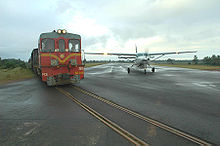|
Fianarantsoa-Côte Est railway
 The Fianarantsoa-Côte Est (FCE) railway is a colonial-built railway in southeast Madagascar that connects the high plateau city of Fianarantsoa to the port-city of Manakara. It is 163 kilometers long and was built by the French between 1926 and 1936 using the forced-labor program SMOTIG. The French used rails and ties taken from Germany as World War I reparations to build the line. Many of the railways still have the date of manufacturing on them dating back to 1893.[1] This line traverses some of the most threatened habitat in the world.[citation needed] In 2000, back-to-back cyclones caused 280 landslides and four major washouts cut service for months until a rehabilitation project was launched with help from USAID, Swiss Railways and others. A study conducted by the Project d'Appui à la Gestion de l'Environnement (PAGE) in 2000 concluded that keeping the train operational helps prevent deforestation to the tune of 97,400 hectares over 20 years.[citation needed] Interviews conducted with villagers during the temporary closure found that they would have no choice but to cut down their tree-based crops that they shipped to market on the railway and plant rice or cassava instead.[1] The FCE is currently running, but its aging infrastructure makes it vulnerable to service disruptions caused by broken rails, old rolling stock and landslides caused by cyclones.[citation needed] The railway crosses the runway of Manakara Airport, one of only three places in the world where a railway crosses a runway at grade.[citation needed] Stations
Rolling material
In 2020 the FCE received three Spanish second hand locomotives[4] Serie 1500 de Renfe built in 1964. See alsoReferences
External links
|
||||||||||||||||||||||||||||||||
